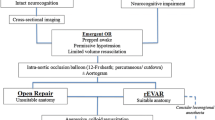Abstract
Thoracic aortic aneurysms are typically asymptomatic and discovered incidentally on an imaging study ordered for other indications. Small aneurysms are managed with antihypertensive therapy and surveillance imaging, using either echocardiography, computed tomographic angiography (CTA), or magnetic resonance angiography (MRA). Aneurysms are repaired when the risk of rupture or dissection exceeds the risk of repair; size thresholds for repair are determined by the underlying etiology of the aneurysm, with lower thresholds for those with genetic aortopathies. In contrast to the silent and asymptomatic nature of aneurysms, acute aortic syndromes—which include aortic dissection, intramural hematoma, and penetrating atherosclerotic ulcer—are usually associated with recognizable symptoms and signs. Acute aortic syndromes involving the ascending aorta are treated with emergent surgery, whereas those involving the descending aorta are now often treated with endovascular stent-grafting techniques. After acute aortic syndromes have been successfully treated, prognosis is favorable with close follow-up that includes optimal medical management and regular surveillance imaging.
Similar content being viewed by others
References
Papers of particular interest, published recently, have been highlighted as: • Of importance •• Of major importance
Elefteriades JA, Sang A, Kuzmik G, et al. Guilt by association: paradigm for detecting a silent killer (thoracic aortic aneurysm). Open Heart. 2015;2: e000169.
Douglas PS, Garcia MJ, Haines DE, et al. ACCF/ASE/AHA/ASNC/HFSA/HRS/SCAI/SCCM/SCCT/SCMR 2011 appropriate use criteria for echocardiography. J Am Coll Cardiol. 2011;57:1126–66.
Goldstein SA, Evangelista A, Abbara S, Arai A, Asch FM, Badano LP, et al. Multimodality imaging of diseases of the thoracic aorta in adults: from the American Society of Echocardiography and the European Association of Cardiovascular Imaging: endorsed by the Society of Cardiovascular Computed Tomography and Society for Cardiovascular Magnetic Resonance. J Am Soc Echocardiogr. 2015;28:119–82.
Evangelista A. Imaging aortic aneurysmal disease. Heart. 2014;100:909–15.
Nishimura RA, Otto CM, Bonow RO, et al. 2014 AHA/ACC guideline for the management of patients with valvular heart disease: a report of the American College of Cardiology/American Heart Association task force on practice guidelines. J Am Coll Cardiol. 2014;63:e57–185. doi:10.1016/j.jacc.2014.02.536.
Bicknell C, Powell JT. Aortic disease: thoracic endovascular aortic repair. Heart. 2015;101:586–91.
Groenink M, den Hartog AW, Franken R, et al. Losartan reduces aortic dilatation rate in adults with Marfan syndrome: a randomized controlled trial. Eur Heart J. 2013;34:3491–500. First prospective randomized trial of losartan on Marfan adults.
Lacro RV, Dietz HC, Sleeper LA, et al. Atenolol versus losartan in children and young adults with Marfan’s syndrome. New Engl J Med. 2014;371:2061–71. This large randomized controlled trial showed that losartan was not superior to atenolol in reducing aortic root growth rate in Marfan syndrome.
Franken R, den Hartog AW, Radonic T, et al. Beneficial outcome of losartan therapy depends on type of FBN1 mutation in Marfan syndrome. Circ Cardiovasc Genet. 2015;8:383–8. This article connects clinical effect of losartan to different genotypic mechanisms of Marfan syndrome.
Hiratzka LF, Bakris GL, Beckman JA, et al. ACCF/AHA/AATS/ACR/ASA/SCA/SCAI/SIR/STS/SVM guidelines for the diagnosis and management of patients with thoracic aortic disease. Circulation. 2010;121:e266–369.
Klompas M. Does this patient have an acute thoracic aortic dissection? JAMA. 2002;287:2262–72.
Shiga T, Wajima Z, Apfel C, et al. Diagnostic accuracy of transesophageal echocardiography, helical computed tomography, and magnetic resonance imaging for suspected thoracic aortic dissection: systematic review and meta-analysis. Arch Intern Med. 2006;166:1350–6.
Asha SE, Miers JW. A systematic review and meta-analysis of d-dimer as a rule-out test for suspected aortic dissection. Ann Emerg Med. 2015;66:368–78.
Fattori R, Montgomery D, Lovato L, et al. Survival after endovascular therapy in patients with type B acute aortic dissection. J Am Coll Cardiol Intv. 2013;6:876–82.
Nienaber CA, Kische S, Rousseau H, et al. Endovascular repair of type B dissection: long-term results of the randomized intervention of stent grafts in aortic dissection trial. Circ Cardiovasc Interv. 2013;6:407–16. This key trial reported long-term outcomes of stent-grafting in acute type B dissection, challenging the notion of “uncomplicated” type B dissection.
Compliance with Ethics Guidelines
Conflict of Interest
The authors declare that they have no competing interests.
Human and Animal Rights and Informed Consent
This article does not contain any studies with human or animal subjects performed by any of the authors.
Author information
Authors and Affiliations
Corresponding author
Additional information
This article is part of the Topical Collection on Peripheral Vascular Disease
Rights and permissions
About this article
Cite this article
Dudzinski, D.M., Isselbacher, E.M. Diagnosis and Management of Thoracic Aortic Disease. Curr Cardiol Rep 17, 106 (2015). https://doi.org/10.1007/s11886-015-0655-z
Published:
DOI: https://doi.org/10.1007/s11886-015-0655-z




